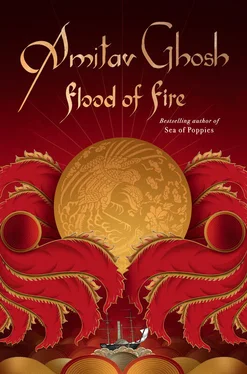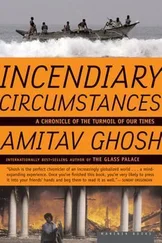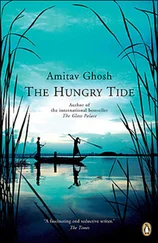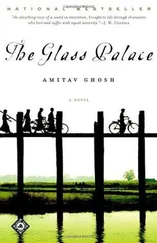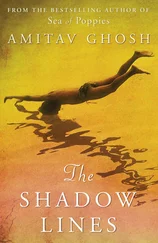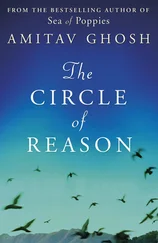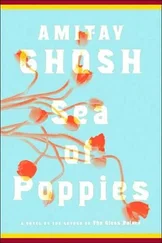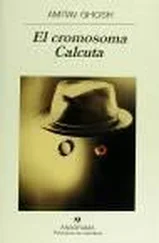Now Mr Burnham again made a beckoning gesture, at which another man stepped forward to join him and Zachary. This caused something of a stir — for when this man, who was dressed in an impeccably cut suit, turned to face the assembly he was seen to be Chinese.
‘Ladies and gentlemen,’ said Mr Burnham, ‘it gives me the greatest pride to announce that from this time on the firm of Burnham and Reid will be working closely with our good friend, Mr Leonard Chan.’
Now, taking Zachary’s wrist in his right hand and Mr Chan’s in his left, Mr Burnham hoisted up their arms and held them aloft in triumph.
*
One of the few spectators to remain in the godown was Baboo Nob Kissin who was looking on from a dark corner at the back. When the three men made their gesture of triumph his heart flooded over with the joy that comes from seeing a mighty endeavour brought to its intended conclusion. Tears came into the gomusta’s eyes as he recalled the day he had first beheld Zachary, on the Ibis : that he should have been transformed so quickly from an ingenuous, good-natured boy, into a perfect embodiment of the Kali-yuga, seemed to Baboo Nob Kissin nothing less than a miracle; he marvelled to think that a creature as humble as himself should have played a part in bringing about the change. He knew of course that his role in promoting the ascendancy of the triumphant trio was but a small one — yet he was certain also that when the day of reckoning arrived, and the Kalki avatar manifested itself on earth, he would not be denied the credit for having advanced the coming of the pralaya by at least a decade or two. To be awarded that much credit would be enough for him; he wanted no worldly reward or recognition for being the first of his compatriots to recognize that it was their assigned destiny to serve the Kalki’s chosen precursors, to be their faithful gomustas in hastening the end of the earth.
It occurred to him also that it was the Ibis , that marvellous vehicle of transformations, that had launched him on the path of destiny and he was seized by an uncontrollable urge to clasp his eyes once again upon that vessel of blessed memory. In a swirl of saffron, he ran outside — but only to be confronted with yet another miracle: the Ibis , which had for the last several days been at anchor off East Point, was gone.
*
In Deeti’s shrine, high up on the slopes of the Morne Brabant, at the south-western corner of Mauritius, there was a special chamber for that episode of Maddow Colver’s life that came to be known as ‘the Escape’. This part of the ‘memory-temple’ was especially beloved of the Fami Colver, particularly the young ones, the chutkas and chutkis, laikas and laikis: every year, during the Gran Vakans, when the family made its annual pilgrimage to the ‘memory-temple’, they waited breathlessly for that moment when Deeti would point to the stylized image of a sampan, with six figures seated inside: Serang Ali, recognizable by his blood-red mouth; Jodu with his three eyebrows; Neel, with his journals; Raju, in his fifer’s hat; Kesri, who, by convention, was always drawn with a bundook — and of course, the patriarch himself, Maddow Colver.
‘Ekut, ekut!’ Deeti would cry, and that great horde of bonoys, belsers, bowjis, salas, sakubays and other relatives would follow her finger as she traced the path of Jodu’s sampan as it edged across the bay, from the Kowloon side, to draw up beside the Ibis , which was all but empty, with the second mate away at the land auction, and the sailors either ashore or asleep.
There vwala!
Her finger would come to rest on Serang Ali: You see him, this gran-koko with a head teeming with mulugandes? This is the great burrburiya who had once again thought up the plan for their escape.
You see now, how he vaults on deck, with Jodu and Maddow behind him? In a matter of minutes the crew are locked up in the fo’c’sle and then Kesri, Raju and Neel come aboard too.
In a trice the sails are hoisted and filling with wind, and by the time the auction ends the schooner is long out of sight …

In embarking on the task of writing a history of the Ibis community, the author had hoped to include an account of the materials on which his narrative is largely founded: that is to say Neel’s archive, by which is meant not only his notes and jottings but also the extensive collection of books, pictures and documents that he accumulated during the years in which he ran a printshop in Shanghai, in partnership with Compton (Liang Kuei-ch’uan).
For this author no part of this history is of greater interest than that of the archive’s survival: indeed, it was once his fond hope that this episode would provide the climactic tamám-shud to this chronicle. But to arrive at that story, in its proper temporal sequence, would require the narrative to move forward by almost a century — that is, to the years immediately preceding the Second World War, which was when Neel’s great-grandsons smuggled the most important parts of the archive out of China.
The unfortunate reality however is that ten years of diligent application have so far succeeded in advancing the narrative by only four years: from 1838 to 1841. Such being the case, with nearly a century’s-worth of events still to come, the author is compelled to acknowledge that it is highly unlikely that he will be able, in the years that remain to him, to provide a full account of the archive’s survival. But to tell this tale hurriedly, out of its proper order in the sequence of events, would, for him, be a betrayal of the enterprise: he would prefer that it remain forever untold than be related in such a fashion.
For the purposes of the present volume suffice it to say that the war in China dragged on for another fifteen months after Neel’s escape on the Ibis , in June 1841. Through this period Neel kept careful track of the movements of the British expeditionary force (now vastly expanded) as it advanced northwards in the direction of Beijing, successively attacking Xiamen, Zhoushan, Ningbo and Shanghai, thereby causing so much destruction and such extensive loss of life that the Daoguang Emperor was ultimately forced to authorize his representatives to capitulate to the invaders’ demands.
The most important of these concessions were: the formal ceding of Hong Kong; the opening of five ports to foreign trade; and the payment of an enormous indemnity, amounting to a total of twenty-one million silver dollars. The agreement that formalized this capitulation came to be known as the Treaty of Nanking and was signed on 29 August 1842, on the HMS Cornwallis (of which Neel wryly notes that ‘this ship, built in the Wadia shipyard in Bombay, was named after a man whose name will forever be preceded by the epithet “Butcher” — fitting that his remains lie in Ghazipur, a stone’s throw from the Opium Factory’).
The text of the treaty was widely circulated, in English, Chinese and other languages: an artist called Henry Cullen even produced a photographic print of it. Neel succeeded in acquiring a copy, at great expense, but it roused him to such a passion that he proceeded to deface it by scribbling comments in the margins, and by underlining certain passages — for example the provision that abolished the old Co-Hong trading system. A clause that attracted his special ire was that which required the British and Chinese governments to henceforth deal with each other on a ‘footing of equality’ through direct exchanges between their appointed representatives. Neel notes sardonically that, as so often when Westerners use words like ‘equality’, this clause was clearly intended to mean exactly the opposite of what it said: that it would be the British who would now dictate the terms of the relationship. He notes similarly, alongside the clause that required China to compensate the British for the costs and injuries of their invasion: ‘So it was the Chinese who had to pay for the catastrophe that had befallen their country!’
Читать дальше
